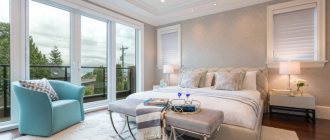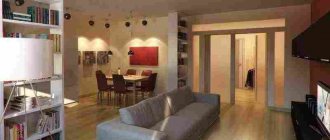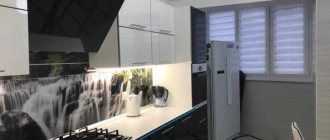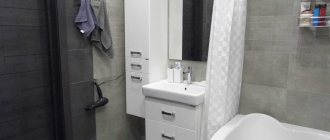Room zoning is relevant for any room - small and large, isolated and open, bedrooms and living rooms. The methods of dividing space are simple and well known to everyone: highlighting zones using color schemes, using different wallpapers, floor coverings, etc. But if the renovation is behind you and global changes are clearly not in your plans right now, you can always find an alternative solution. Today we will talk about how to properly use curtains in zoning.
Zoning with curtains can be not only functional, but also a purely decorative technique - they are often used to decorate arches or doorways.
Where is zoning of areas relevant?
Radical techniques for isolating space are necessary in one-room and densely populated apartments. In other cases, they resort to zoning rooms with curtains in order to diversify the interior. In a spacious hall you can, for example, separate a seating area.
Zoning the living room space with curtains
It’s easy to organize your workspace in this way, by allocating a place for it, even in the hallway. Such a technique would not be superfluous in arranging a nursery belonging to even one child. The intimacy of the sleep area will only make the child’s rest more complete.
Zoning the sleeping area in the nursery using curtains
Architectural designs
Architectural and planning features of the room, in particular, the location of window and door openings, the presence of arches, niches, projections, columns, beams and supports, sometimes successfully correlate with zoning goals.
▪ Window, door A window (as well as a balcony or interior door) with wide walls on the sides sets a conditional dividing line relative to which zones are placed.
▪ Opening An extended rectangular passage without installing a door.
▪ Arch
▪ Niche Some apartment layouts provide a special niche for the bed.
▪ Wall projection
▪ Column A single column or a pair on the sides of a wide opening.
▪ Ceiling beam
▪ Attic support
Zoning space with curtains: type classification
How the premises will be landscaped depends, first of all, on the original purpose of using its space. Zone isolation can be:
- full or partial;
Partial zoning with curtains
- temporary or permanent;
Permanent insulation with curtains
- functional or decorative.
Decorative zoning with curtains
Furniture
Zoning with furniture is the most functional way to create additional storage space.
Large items such as a wardrobe, cabinet, chest of drawers, shelving and upholstered furniture are especially suitable for these purposes. ▪ Cabinet, wall
▪ Cabinet
▪ Dresser, chest
▪ Rack
▪ Sofa The boundary of the zones is indicated by the back or short section of the corner sofa.
Back:
Corner section:
▪ Table
▪ TV stand
▪ Armchair, chair, bench, banquette, pouf
▪ Floor hanger
Advantages of zoning using curtains
“Zoning a room with curtains is an opportunity to regularly update the decor”
Using light curtain partitions in the design of a room, instead of stationary walls, to highlight functional areas is a very justified solution. First of all, there is no need for large material costs. The structure can be assembled without resorting to major repair work and without using complex equipment. The fabrics themselves for zoning and decorative details for such a partition can generally be cut out and assembled into a structure with your own hands.
Zoning with curtains is easy to do yourself
The curtains are ergonomic. They absolutely do not steal space, even if heavy fabric is used for this role.
Most partition curtains are designed for temporary use. They can always be removed from the interior, and the design of the room will not be affected.
Zoning a room with curtains is also an opportunity to regularly update the decor. By changing the curtains themselves or the accessories decorating them, you can present the interior from a completely unexpected perspective at any time.
Curtains will make it easy to update the interior of a room
But the greatest value of curtain partitions is their mobility. Curtains should only be closed if necessary. The rest of the time, the space may well remain a single whole.
Structural variety of curtain partitions
Zoning space with curtains can be done:
1. By frame method.
2. By hanging method.
Frame structures
A feature of this option is the need to assemble a rigid frame, which is subsequently tightly covered with fabric. The base can be solid or prefabricated, that is, consist of separate sections. In the first case, the partition will be either permanently standing or sliding. In the second, it will be able to fold to a minimum size.
Frame type of zoning
Suspended structures
Externally, such a partition is practically no different from window curtains. The only distinguishing feature is the non-standard method of fixation. Fabric for zoning is hung on a ceiling cornice or string and its sheets hang freely from them.
Suspended structure for zoning space
Zoning a room with curtains can be done in different design solutions.
Classic version
The design uses a regular curtain. The panel is hung on a string or cornice. In the case of highlighting a sleeping area, it is preferable to use dense, heavy textiles, as they can reproduce the effect of the presence of a wall with maximum accuracy.
Heavy curtains look great hanging from thick rings running along a massive cornice. This approach is not only aesthetically pleasing. It's also practical. The curtains will not sag, and the partition, and with it the room, will always have a neat appearance.
Classic option for zoning a sleeping area
If the space is divided solely for decorative purposes, then zoning the living room and bedroom is possible with light curtains hung on inconspicuous thin strings.
Thread curtains
Such curtains, like transparent fabrics, are used for zoning when it is necessary to purely visually highlight and effectively draw the boundaries of functional areas. Translucent thread curtains will not interfere with free movement around the room and will not interfere with its visibility.
Zoning with thread curtains will not make the space heavier
It is appropriate to resort to zoning a room with thread curtains when you need to separate a work space in it. This solution is more than successful in the bedroom, where the baby sleeps in his crib with his parents. On the one hand, parents get an intimate area, on the other hand, they have unhindered control over the children's corner. The thread curtain does not collect dust and does not interfere with normal air circulation, which is also important in this interior.
Thread curtains do not interfere with free air circulation
As an alternative to thread models, beaded curtains can be used to zone the living room. They look bright, unusual and are quite worthy of becoming a decorative highlight. They can be assembled to your taste and with your own hands, thus obtaining a truly exclusive design element.
Curtains made of beads will become a decorative highlight of the interior
Roller blinds
This is a real camouflage option. You can hide anything behind curtains that run on rails: from a small storage room in the hallway to a dressing room in the bedroom.
Blind zoning with roller blinds
Zoning a space with curtains of this type is, first of all, practical. If you put polyvinyl chloride fabric on the canvas, which is easy to clean and is not prone to absorbing odors, then with a curtain design it will be quite possible to separate the living room and kitchen or, in general, to separate the work area from the dining area inside the kitchen itself.
Separation of working and dining areas
Blinds
Vertical blinds are interesting in zoning rooms with curtains. They are easy to use and almost invisible when assembled.
Interior zoning with vertical blinds
Dividing rooms with sliding structures
Tall sliding structures, depending on the material, can completely block access to one of the zones, or perform only a decorative function. The first option is good if you need to zone a child’s room, because the child psychologically needs individual space. The second solution is perfect for separating large living rooms combined with kitchens.
This design has several significant advantages:
- When closed, partitions, especially solid ones, completely prevent unauthorized access to one of the zones;
- When open, the structure does not take up much space; only one of the doors is visible;
- A wide range of materials and the ability to make a partition according to an individual order, taking into account the size of the room, allow the structure to fit into any interior as an effective addition.
Most often, people decide to zone the space of their home with sliding partitions precisely because of the huge variety of materials from which they can be made.
The simplest budget option is an accordion partition made of plastic or plexiglass. It takes up minimal space when folded and is very easy to fold.
Although, of course, glass looks the most impressive.
Zoning rooms with glass partitions
Even a simple glass partition immediately attracts the eye, not to mention stained glass, printed glass, a combination of mirrors or matte patterns on a transparent background.
However, glass does not provide a psychological feeling of complete privacy and isolation from other people, and residents need this from time to time.
It is undesirable to separate the children's room with a glass partition, especially if there are also pets in the house. This is because glass partitions can break. Despite all the assurances of manufacturers, even heavy-duty glass breaks.
Zoning rooms with wooden partitions
Partitions made of thin polished wood are a wonderful addition to a classic-style interior.
You can make an insert of glass (frosted or with small patterns) so that in a small space the partition does not look too massive.
A bedroom or office fenced off in this way looks good. But it is not advisable to use wood near the kitchen - it quickly deforms due to high humidity and steam.
Aluminum partitions
Aluminum structures in country houses are relatively rare, since when they are used, dents appear quite easily on such thin metal.
If you often have noisy groups, this is definitely not your option. However, for one person, a childless couple or an older couple, this solution is quite suitable.
Partitions made from natural materials
A leather, wicker rattan or bamboo partition will organically fit into an interior in an ethnic or country style.
Such designs will undoubtedly complement the naturalness of any eco-interior. However, it must be taken into account that they will deteriorate faster when compared with traditional materials. Plus, they are more difficult to remove and clean (dust and dirt quickly clog into small holes).
What are the pros and cons of sliding partitions?
Such designs look very impressive, especially if they are made entirely of glass from floor to ceiling.
The second plus: thanks to the sliding mechanism, you automatically get both a new wall and a door. That is, you don’t have to spend money on buying a door and installing it.
However, sliding partitions also have significant disadvantages:
- Most manufacturers do not make partitions higher than 2-2.5 meters in height, or it will cost many times more;
- If you install the partition not up to the ceiling, be prepared for the fact that there will be no sound insulation between the zones at all;
- Such structures require periodic maintenance. Otherwise, they will quickly become unusable.
As for the type of mechanism, it can be rail or non-threshold. In the first case, guides are mounted on the floor and ceiling along which the doors move.
This is almost invisible in a spacious room, but in a small room it is striking. This design provides more reliable sound insulation, but moves apart with noticeable noise.
Threshold-free partitions (move on rollers attached to the upper end). They are practically silent, making them better suited for children's rooms and bedrooms.
How to fit a textile partition into the interior
In order for zoning with curtains to be perceived as an adequate solution, you should not neglect the following tips. The curtain fabric must have a certain rigidity in order to keep its shape, then, falling, it will form smooth, beautiful folds, which will eliminate the element of sloppiness in the setting.
Curtain fabric must have a certain rigidity
If it is decided to perform zoning using curtains, then the fabric partition should have a maximum length and literally rest against the floor, completely enclosing the space hidden behind it in the vertical plane.
Fabric combinations are acceptable. You can hang light tulle and a thick curtain on the cornice. In this case, a translucent curtain will decorate the interior and contribute to its adequate lighting. The area will be fenced off with a thick curtain only when necessary.
Combined zoning with curtains will allow you to regulate lighting
Since small-sized rooms most often need zoning with curtains, it would be more correct to use light-colored or generally translucent fabrics for the partition. Thread models perfectly adjust space. They add volume to the room and make the atmosphere weightless.
Thread curtains add volume to the room
However, if the task is to separate the sleeping area from the place where guests are received, then heavy curtains are used in zoning the living room.
In a studio apartment, thread curtains in combination with climbing plants are more relevant. The house will immediately be filled with a summer mood. Moreover, with each swing of such curtains, you will get the feeling of a pleasant light breeze passing through the apartment.
Transformable partitions
Sliding compartment partitions and folding accordion doors easily divide the space into chamber zones and combine it back into one whole.
▪ Compartment partitions Threshold-free sliding systems with top suspension are preferable to rail systems.
▪ Accordion doors
Zoning with Japanese curtains
“Japanese curtains are ideal for zoning a space decorated in any style”
This element is given a special place of honor in the design of one-room apartments. Japanese curtains, which take up minimal space and free up maximum space, make interiors elegant and claim to be original. Fabrics for zoning are usually taken in pastel colors. They harmonize perfectly with the natural wood in the setting, and softly diffuse the light, emphasizing the aesthetics of textile inclusions.
Zoning with Japanese curtains
To create a composition, several canvases are used, which can be the same in color and texture, or differ in these parameters.
Japanese curtains used in space zoning are easily controllable, so it will always be possible to adjust the level of illumination in the room and modify the boundaries of the location of zones.
Zoning with Japanese curtains is easy to control
Features of structure fixation
Used as a partition, Japanese curtains move along a rail-like mechanism fixed to the ceiling, to which they are attached with Velcro or special carriages. The number of guides is arbitrary and can vary from a monorail to an extensive network, which includes 5 or more runners. This once again emphasizes that in zoning with curtains everything depends on the design idea.
Japanese curtain fastening system
The canvases can also be arranged at your own discretion: lined up in a row, placed on a ladder, placed behind each other. Fabrics for zoning are selected in accordance with the style of the partition. Usually this:
- linen;
- cotton;
- silk.
However, sometimes the material of choice becomes:
- rice paper;
- bamboo;
- plastic;
- reed;
- rattan.
The material of Japanese curtains is selected in accordance with the interior style
Although the density of the canvas is varied, the color decor always fits into calm, soft colors. The exception is modern interiors, where zoning a room with curtains plays an accent role. Here you can see contrasting solutions, for example, in the red-black spectrum.
Japanese curtains that play a contrasting role in the interior
The prints are also quite symbolic, characteristic of Japanese style. The curtains can be decorated with sakura branches, hieroglyphs, dragons, and colorful birds.
In which rooms is it justified to install Japanese curtain partitions?
Elements such as Japanese curtains need space, especially if they are intended to move freely around the room, so they can often be found in the decoration of studio apartments and large living rooms. Aesthetic panels will satisfy the needs of connoisseurs of extravagant and minimalist interiors, although, by and large, Japanese curtains are ideal for zoning a space decorated in any stylistic manner.
Japanese curtains are ideal for zoning space in any style
Using partitions of this quality will make it possible to constantly change the decor and layout of the room, each time presenting the room in a new light.
Since Japanese curtains do not form draperies or waves, a lot of dust does not collect on them. And it won’t be at all difficult to remove the minuscule amount that has accumulated. If they cannot be removed from the frame and washed, you can always wipe them with a damp cloth or vacuum them.
Interior and decor items
For conditional zoning, it is enough to place a floor vase, sculpture, aquarium or terrarium on a stand, decorative fountain, plant, fireplace, life-size mirror or other large and beautiful interior item on the border of day and night areas.
The method is suitable for those readers of kvartirastudio.ru who have already completed the renovation. ▪ Plant, green compositions A large tub plant or a group of flower pots on a stand or special rack form a living partition. Among the large-sized plants for the home, ficus, palm, monstera, dracaena, yucca, sansevieria, zamioculcas, croton, citrus fruits, spurge, dieffenbachia, and spathiphyllum are popular. Away from the window, you should provide the flowers with sufficient artificial lighting, or use fakes.
Zoning curtains for a studio apartment
Creating comfort in large areas is also a troublesome task. Here problems of a different kind arise. You will have to think about the harmonious organization of space and adding comfort to it. Zoning space using curtains in this matter is universal. The method will help make both the small apartment and the apartment a truly wonderful nest.
If in a one-room apartment there is most often a need to divide the room into a sleeping and guest area, then in a studio apartment you will also have to designate a kitchen, and perhaps a study. Here again it makes sense to remember the extensive zoning of Japanese curtains. A design trick will help add color to the room. This solution is very appropriate in minimalist spaces.
Zoning with Japanese curtains in a studio apartment
If you want to add oriental notes, romanticism, luxury to the decor, you should take a closer look at the various canopies and canopies.
For zoning a living room with curtains, a very good trick is using a double-sided canvas decorated with a themed 3D pattern. Photo curtains are also very popular.
Studio zoning with photo curtains
Lighting
The division of the room is also carried out using different lighting sources and scenarios.
For this purpose, both individual lamps and built-in lamps are used and mounted in the ceiling, walls, floor and furniture. ▪ Border lighting fixture (floor lamp, floor lamp)
▪ Local light General uniform light visually unifies the space, and local lighting sources create light spots. For example, a chandelier or floor lamp in the guest room and a table lamp, sconce or headboard lighting in the sleeping area. To maintain stylistic unity, all lighting fixtures are selected from the same collection.
▪ Brightness and color More powerful illumination of the day area and subdued private lighting, hidden lighting of different colors.
Zoning the children's space with curtains
Kids love unusually designed interiors, especially those where cozy little holes are created for them. They value individual space very much because they feel relaxed in it, as they are hidden from prying eyes. It is more convenient to realize a childhood dream by zoning the room with curtains. For example, they can be used to fence off a playing area.
Zoning children's space with curtains
Naturally, leaving a child out of sight is the height of carelessness, so you will have to use a trick and choose transparent fabrics for zoning. By making the curtains visible, you will kill two birds with one stone: the child will receive the coveted personal space, and you will have the opportunity not to lose sight of him.
To zone the nursery, choose the fabrics you are viewing
You can focus on the sleeping area and highlight the crib with curtains. Boys will definitely love to fall asleep looking at the unusual flying objects depicted on the canopy. Girls would rather prefer lush canopies, which turn even the simplest bed into a bed quite worthy of young princesses.
Zoning a children's bedroom with curtains can be considered a godsend if two children, especially of opposite sexes, have to live in it at once. The choice of fabric quality for zoning is made based on the tasks assigned to the curtains. If this is a purely decorative aspect, then in a girl’s room it is quite possible to limit yourself to something light, flowing, perhaps even lace.
Zoning a nursery for two children with curtains
Boys favor stricter decisions. Here you will need materials printed on topics that interest them. The colors of the curtain partitions are selected accordingly. Young ladies are always comfortable surrounded by soft pink and beige tones, and boys - blue and white.
When zoning curtains for a child’s room, you can also make extraordinary decisions and use a compromise double fabric in the room of children of different sexes, one side of which is decorated in girlish colors, and the other in boyish colors.
This is not just an opportunity to easily fit an element into the environment, it is a real opportunity to make the environment psychologically comfortable for every child. And personalization of the partition design will contribute to this.
Bright zoning for children's
Color
The zoning of the room is done both by the color of the finishing materials, as discussed above, and by the color of the upholstery and textiles (bedspreads, linens, pillows) of the main furniture - the sofa and bed.
Bright and dynamic colors are suitable for the living room, calm and relaxing ones for the bedroom. The color of the furniture in contrast with the wall decoration accentuates the area, and in tone or close to it, on the contrary, makes it less noticeable. A dark sofa stands out, and a light bed is hidden against the background of a white wall:
There is an inversion technique when two colors (in the photo below - white and red) are used for decoration and furniture of different areas in the reverse order.
Zoning the bedroom with curtains
The bedroom can rightly be called the kingdom of textiles. There really is a lot of it here and it is appropriate, so why not use fabrics for zoning the space? Curtains will do the job wonderfully. Behind them you can hide a dressing room or set up a study. They can be entrusted with the role of doors by decorating doorways and built-in wardrobes in fabric.
Selecting a workplace in the bedroom with curtains
Fabric draperies have become a traditional option for decorating alcoves with sleeping places. If this zone is isolated with a blank partition, no matter what type of structure, then it will be perceived more like a closet than a place for comfortable rest. Zoning with a light curtain will not only not interfere with the quality of ventilation in the niche, but will also allow you to regulate the degree of privacy of the atmosphere in the room as a whole.
Curtains allow you to regulate the degree of privacy in the bedroom
In the design of an adult bedroom, canopies are also often found, but their shape is more strict than in children's bedrooms.
Ceiling
Some types of finishing, design and ceiling decor allow you to visually divide the living room and bedroom.
Materials for the ceiling: whitewash, paint, wallpaper, polystyrene tiles, plastic panels, metal slats, cassettes, drywall, plaster, stretch fabrics (PVC film, fabric) and even laminate. ▪ Finishing Finishing materials with noticeable differences in color, pattern, texture or type are selected for different parts of the room.
▪ Multi-level ceiling The difference in ceiling level between the day and night zones.
▪ Decor An accent element on the ceiling above one of the areas.
Stylish zoning using curtains
The stylistic nuances of zoning space with curtains should be discussed separately. In principle, textile partitions are acceptable in many areas, including loft, but they are still the most frequent guests:
- in shabby chic,
- Provence,
- vintage interiors,
- Provence,
- country,
- rustic style.
Zoning interior curtains in Provence style
Here, not only the room area is zoned with curtains. They are used for the role of interior doors and even wardrobe doors and wardrobes.
Curtains made of threads, creating lightness and adding airiness to the space, are in demand in interiors of modern styles, Provence and country. By the way, they can consist not only of them, but also of palettes, beads, shells, and perhaps even assembled from metal chains.
Zoning the space with bright thread curtains
Rustic motifs are perfectly complemented by partitions made of draped, natural fabric, suspended on wooden cornices.
But classic interiors will require luxury. Fabrics for their zoning: satin, velvet, velor. The drapery is decorated with lambrequins, fringes, tassels, and gold lacing tiebacks and other delights are added.
Zoning a classic interior with velvet curtains
Textiles in noble colors, decorated with floral patterns, are in demand in Art Nouveau. When zoning a living room, curtains with this design will always be an accent element, bringing with them expansion.
Don’t think that the curtains used to zone the space of a stylish living room or bedroom differ only in the quality of the fabric. They have different cuts, textures, and methods of fastening, which helps to fit them into any interior solutions.
Interior zoning in Art Nouveau style with curtains
Fabric partitions can be full or partial, stationary or mobile, opening in a horizontal or vertical plane. Prominent representatives of lifting structures are French awnings and Roman blinds.
Mobile zoning with Roman blinds
Their design and shape will also depend on many factors: stylistic requirements, the quality of materials used, whether the canvas will be folded or left as a flat hanging panel.
Fabrics for zoning and correction of room space
It would seem that a more ergonomic and virtually space-free partition for zoning a room than curtains could not be found. However, this characteristic is true for fabrics only on a physical level, but on a visual level they can turn out to be very insidious. Fleecy and large-patterned materials, heavy curtains and thick draperies will mercilessly “steal” the space. They should not be used as partitions in the design of small rooms. Here it is better to resort to zoning the space with visible curtains made of tulle, muslin, and threads.
Light curtains do not weigh down the interior of the room
Choosing colors for curtains
Choosing a color solution for such an idea needs to be balanced and thoughtful. Otherwise, you can ruin the whole feeling of your living space. It is important to take into account the color space that has already been formed, as well as the style that is available or that is planned to be implemented.
The color of the curtains used for zoning should be combined with the overall atmosphere of the room
Zoning with translucent curtains is more decorative than functional.
Despite this, there are some general rules:
- If the room is small in size, then under no circumstances use dark and bright colors. Do not take fabrics with large patterns.
- Consider the harmony of curtains with wallpaper and floor.
- It is better to take the material for dividing the space exactly the same as the curtains in the room.
- For Khrushchev, canvases that are neutral in color and texture without a pattern are suitable.
- For the nursery and bedroom, choose the most neutral shades, for example, any pastel colors.
Some tips
When planning to drape a textile partition, choose a fabric that can hold its desired shape. Remember, just as smooth folds will decorate the interior, so “loose” folds will make it untidy.
Never use curtains made from fabrics that are difficult to iron when zoning a living room, especially. They will simply ruin her appearance.
When decorating rooms with one window with partitions, give preference to combination solutions. Use a combination of sheer and heavy curtains. This will make it possible to clearly divide the space and not reduce the intensity of natural light in the room, since thick curtains can be closed only as needed, while the transparent part will always remain in place.
Select the density of fabric for zoning in accordance with the functions assigned to the partition. If its task is not to let in light and bring intimacy into personal space, it is recommended to sew it with jacquard, viscose or other high-density materials such as blackout. Less expensive cotton fabrics can handle other tasks just fine.
Floor
Certain finishing techniques and flooring also help to zone the living room-bedroom.
Flooring materials: parquet, laminate, wooden boards, ceramic tiles, stone, linoleum, carpet. ▪ Variations in finishing For both parts of the room, the same type of flooring is used, but in different colors, patterns, and laying directions. For example, parquet boards of several types of wood, laminate or tiles in different layouts (lengthwise, crosswise, diagonally).
▪ Different finishes Two floor coverings are joined at the border of the bedroom and living room in a straight or curved line. For example, parquet and carpet, tiles and laminate.
▪ Podium One of the zones is raised to a higher level - to the podium.
Guest on the podium:
Bedroom on a podium:
An alternative to a podium is a high bed base with storage systems.
▪ Carpet, skin A simple way to mark the territory after the renovation is completed is to put a fluffy carpet or animal skin on the floor.











